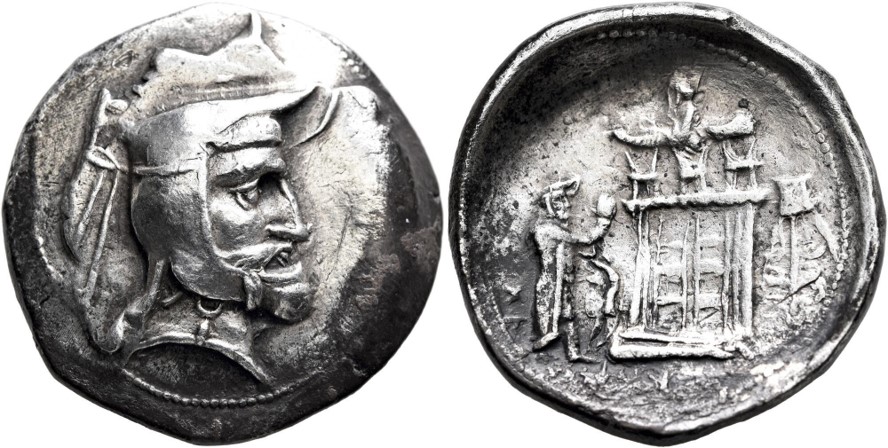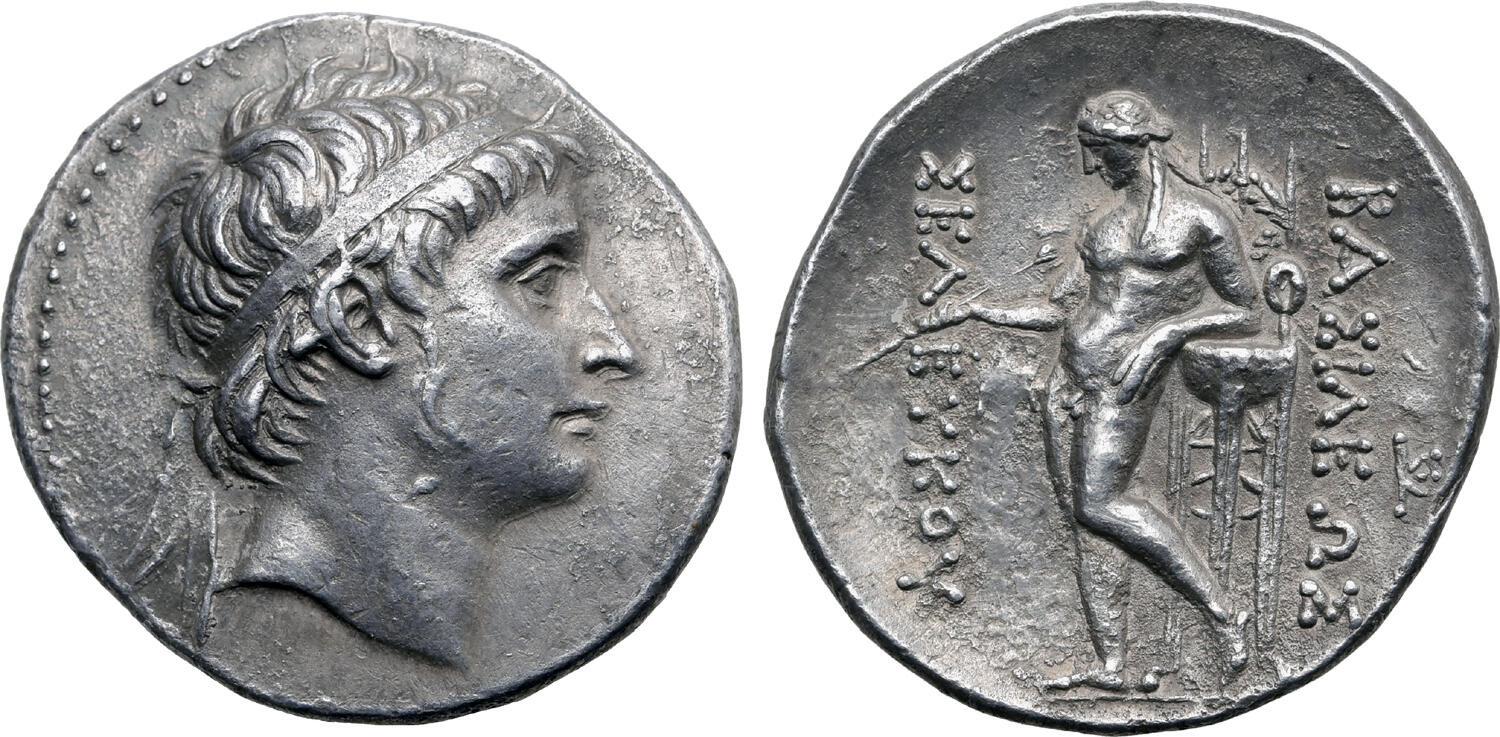240 BCE - 200 BCE | wtpr in Aramaic to outer right; p in Aramaic to inner right; (lh' in Aramaic) in exergue: "Vadfradad, the Frataraka of the Gods, Son"
Overstriking coin
Vadfradat_Leu_Numismatik,_EA_26,_8_July_2023,_1769.jpg
[1]
Overstruck variety
Seleucus_II_Apollo.jpg
[2]
|
|
Sale(s)Sale(s) ᵖ:
|
Leu Numismatik, EA 26, 8 July 2023, 1769
|
|
|
|
Description
| ObverseInscription or printing placed on the obverse.:
|
Head of Vadfradat right, wearing earring, satrapal cap (kyrbasia) and diadem. Border of dots.
|
ReverseInscription or printing placed on the reverse.:
|
wtpr in Aramaic to outer right; p in Aramaic to inner right; (lh' in Aramaic) in exergue: "Vadfradad, the Frataraka of the Gods, Son" (Aramaic) Fire temple of Ahura-Mazda, to left, Vādfradād standing right being crowned with wreath by Nike standing behind, bow set on ground before, standard to right
|
Mint and issuing power
| MintIdentifies the place of manufacture or issue of a numismatic object.:
|
Istakhr (Persepolis)
|
Ancient regionAncient region.
|
Persis
|
Modern countryModern country: Iran
|
AuthorityIdentifies the issuing power. The authority can be "pretended" when the name or the portrait of X is on the coin but he/she was not the issuing power. It can also be "uncertain" when there is no mention of X on the coin but he/she was the issuing power according to the historical sources:
|
Vadfradad II of Persis, Kingdom of Persis
|
Chronology
| FromIdentifies the initial date in a range assigned in a numismatic context. 240 BCE toIdentifies the final date in a range assigned in a numismatic context.. 200 BCE
|
Hellenistic 323-30 BC  periodTime period of the numismatic object. periodTime period of the numismatic object.
|
Physical description
MetalThe physical material (usually metal) from which an object is made.: Silver 
|
WeightWeight of the numismatic object (in grams). in grams: 16.5616.56 g <br />16,560 mg <br />
|
DenominationTerm indicating the value of a numismatic object. Examples: tetradrachm, chalkous, denarius.: tetradrachm 
|
AxisDescribes the directional relationship between the obverse and reverse of a numismatic object.: 1111 mm <br />1.1 cm <br />
|
| DiameterDescribes diameter of an object (in mm).: 3434 mm <br />3.4 cm <br />
|
StandardStandard.: Attic
|
References
Description
| ObverseInscription or printing placed on the obverse.:
|
Diademed head to right
|
ReverseInscription or printing placed on the reverse.:
|
BAΣIΛEΩΣ to right, ΣEΛEYKOY to left (Greek) Apollo standing to left, testing arrow and leaning on tall tripod
|
Mint and issuing power
Chronology
| FromIdentifies the initial date in a range assigned in a numismatic context. 246 BCE toIdentifies the final date in a range assigned in a numismatic context.. 225 BCE
|
Hellenistic 323-30 BC  periodTime period of the numismatic object. periodTime period of the numismatic object.
|
Physical description
| DenominationTerm indicating the value of a numismatic object. Examples: tetradrachm, chalkous, denarius. ᵖ:
|
tetradrachm 
|
StandardStandard. ᵖ:
|
Attic
|
References
| Frequency of overstrikesFrequency of overstrikes:
|
frequent
|
Level of confidenceLevel of confidence of the identification:
|
strong
|
| RemarksRemarks:
|
"This coin was overstruck on a tetradrachm of Alexander III" (nb: wrong identification, different profile; most likely over Seleucus II).
|
References
- ^ Alram, Michael (1986), Iranisches Personennamenbuch. Band IV: Nomina Propria Iranica In Nummis, Vienna.
- ^ Klose, Dietrich O. A. - Müseler, Wilhelm (2008), Statthalter Rebellen Könige - Die Münzen aus Persepolis von Alexander dem Großen zu den Sasaniden, Munich, xii, 90 p.
- ^ Nelson, Bradley R. (2011), Numismatic Art of Persia: The Sunrise Collection Part I: Ancient- 650 BC to AD 650, Lancaster
- ^ van't Haff, Pieter Anne (2020), Catalogue of Persis Coinage, Ca. 280 B.C. - A.D. 228, 2020
- ^ Houghton, Arthur - Lorber, Catharine C. - Hoover, Oliver D. (2008), Seleucid coins : a comprehensive catalogue. Part 2, Seleucus IV through Antiochus XIII, 2 v., New York - Lancaster - London, (xxx), 120 p. of plates : ill., maps, tables
- ^ Hoover, Oliver D. (2009), Handbook of ancient Syrian coins : royal and civic issues, fourth to first centuries BC, The Handbook of Greek Coinage 9, Lancaster, lxix, 332 p.

